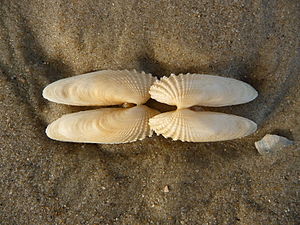American drill shell
| American drill shell | ||||||||||||
|---|---|---|---|---|---|---|---|---|---|---|---|---|

American borer mussel ( Petricolaria pholadiformis ) |
||||||||||||
| Systematics | ||||||||||||
|
||||||||||||
| Scientific name | ||||||||||||
| Petricolaria pholadiformis | ||||||||||||
| ( Lamarck , 1818) |
The American borer mussel ( Petricolaria pholadiformis ), also called angel wing , is a type of mussel from the clams family (Veneridae) in the order of the Venerida .
features
The same-hinged, non-inflated casing of the American drill shell is up to 6.5 cm long and elongated-elliptical. It is very unequal, the vertebrae are in the front half of the case. The lunula is not clearly defined. It is only distinguished from the surface of the case by the radial ribs. An Area does not exist. The ligament is internal, but is also visible from the outside. It is maroon and runs almost the entire posterior dorsal margin.
The lock has two strong teeth in the right flap, the rear of which is split in two. The anterior cardinal tooth is hook-shaped and sits under the vertebra. There are three teeth in the left valve, of which the middle tooth is divided into two parts. But there are no posterior teeth. The siphons can be stretched to about twice the length of the housing and are fused at the base. The surface line is therefore deeply indented.
The whitish to cream-colored skin is thin and fragile. The surface is covered with concentric growth strips and ribs as well as radial ribs. This ornamentation is particularly strong in the front part of the housing; this part is used for drilling in the substrate. The inner edge of the case is smooth. The periostracum is a thin, light brown coating that has a matt sheen.
Geographical distribution and habitat
The species is originally found on the east coast of North America from Prince Edward Island (Canada) over the east coast of the USA to the Gulf of Mexico. In 1890 it was probably brought to Europe on the east coast of England when the American oyster ( Crassostrea virginica ) settled. In 1899 it was found on the Belgian-Dutch North Sea coast. In 1904 it reached the German North Sea coast. In 1930 it had penetrated into the western Baltic Sea. Today it occurs on the entire east coast of the Atlantic from Norway to West Africa, including the Mediterranean and the Black Sea. This new distribution area coincides with that of the white burr mussel ( Barnea candida ), which, however, belongs to a different family of mussels.
Taxonomy
The taxon was first described in 1818 by Jean-Baptiste de Lamarck as Petricola pholadiformis . The species is now part of the genus Petricolaria Stolicza, 1870.
supporting documents
literature
- Fritz Gosselck, Alexander Darr, Jürgen HJ Jungbluth, Michael Zettler: common names for mollusks of the sea and brackish water in Germany. Mollusca, 27 (1): 3-32, 2009 PDF
- Fritz Nordsieck : The European sea shells (Bivalvia). From the Arctic Ocean to Cape Verde, the Mediterranean Sea and the Black Sea. 256 pages, Gustav Fischer Verlag, Stuttgart 1969
- Guido Poppe. Yoshihiro Goto: European Seashells Volume 2 (Scaphopoda, Bivalvia, Cephalopoda) . 221 pp., Verlag Christa Hemmen, Wiesbaden 1993 (2000 unc. Reprint), ISBN 3925919104 (p. 127)
- Rainer Willmann: Mussels of the North and Baltic Seas. 310 pp., Neumann-Neudamm, Melsungen 1989 ISBN 3-7888-0555-2 (pp. 144–146)
On-line
Individual evidence
- ↑ Jean-Baptiste Pierre Antoine de Monet, Chevalier de Lamarck: Histoire naturelle des animaux sans vertèbres, présentant les caractères généraux et particuliers de ces animaux, leur distribution, leurs classes, leurs familles, leurs genres, et la citation des principales espèces qui s 'y rapportent; précédée d'une introduction offrant la détermination des caractères essentiels de l'animal, sa distinction du végétal et des autres corps naturels, enfin, l'exposition des principes fondamentaux de la zoologie. Tome cinquième. Pp. 1-612. Paris, (Deterville, Verdiere, 1818). Online at www.biodiversitylibrary.org (p. 505)
- ↑ MolluscaBase: Petricolaria pholadiformis (Lamarck, 1818)
